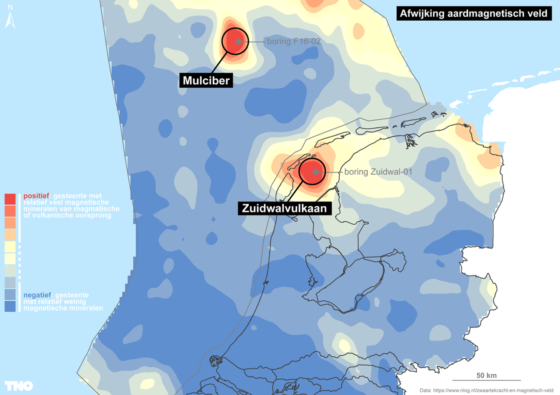ANCIENT VOLCANO DISCOVERED ON DUTCH SEAFLOOR
By Byron Mühlberg on May 9, 2020

The Mulciber volcano (in red) found at the bottom of the North Sea. Three kilometers of sediment lies on top of it.Graphic: TNOTNO
An extinct volcano has been discovered about 100 kilometers off the coast of Texel, the Netherlands Organisation for Applied Scientific Research (TNO) confirmed this week. The 150-million-year-old volcano, named 'Mulciber' after the Roman god of fire, was discovered accidentally by TNO researchers during a reanalysis of old seafloor maps while on the search for oil.
The ancient formation was recognized by deviations in the seafloor's structure, combined with measurements of the earth's magnetic field. According to Michiel van der Meulen, who headed up the Geological Survey of the Netherlands for the TNO, the discovery marks an important moment in the understanding of volcanism in the North Sea.
"The North Sea and the geological deposits in it seem to me to be reading an exciting story. We think we know the big story now. But if as you reread it, characters and storylines become more and more apparent, so this discovery adds to the general knowledge about our living environment," Van Der Meulen explained to public broadcaster NOS on Saturday.
He also explained in a separate statement about the discovery that the volcano will most likely never erupt again. "The chances of the Mulciber erupting are nearly zero. Geologists distinguish between dormant and extinct volcanoes. Dormant means that it is now quiet but can become active again. This is possible after hundreds or even thousands of years of inactivity. But we can declare the Mulciber extinct."
Mulciber is the second volcano to be discovered in Dutch territorial waters. The first, the extinct Zuidwal Volcano, was discovered in 1970 during an oil search. It is located around 2 kilometers below the surface of the Wadden Sea, just off the coast of the Netherlands.
The latest geological find was not confirmed the same way the Zuidwal discovery was made, where an oil company accidentally bored into it. Still, the Mulciber was positively confirmed as a volvano. "Substrate composition, deposits, age, seismic data: everything confirmed the presence of a volcano," said researcher Geert-Jan Vis in a statement.
In addition to Mulciber and the Zuidwal Volcano, there are two active volcanoes in Dutch overseas territories in the Carribean. One of which sits on the island of Saba, and the other on St. Eustatius.
Researchers discover seabed volcano 100 km from Texel
Society
May 9, 2020

Map showing the magnetic field anomalies. Illustration: TNO The geological department of the Dutch research institute TNO has discovered a dead volcano three kilometres below sea level, some 100 kilometres north west of the Wadden island Texel. The newly found volcano, which was named Mulciber after the Roman god of fire and is 150 million years old, was found when scientists were reviewing old geological data of the North Sea on behalf of energy companies in search of gas beneath the ocean floor. What gave the presence of the volcano away were a number of anomalies in the structure of the subsoil and the earth’s magnetic field, geologist Michiel van der Meulen said. Fifty years ago similar changes led to the discovery of the Zuidwalvulkaan, another dead volcano in the Wadden Sea. Van der Meulen said, the North Sea may well hide more. The tally for Dutch volcanoes is now four, including Mount Scenery on Saba and Quill in St Eustatius. Both Caribbean islands, part of the former Dutch colonies in the area, have the status of a Dutch local authority. Van der Meulen called the discovery a one off. ‘How many times in a geologist’s career do you get to find and name a volcano? Studying the North Sea and the geological sediments in it is like reading an great book. We think we know the gist of the story but every time we go back to it we get to know the protagonists and the story lines better. In that sense this discovery adds to what we already know about our living environment,’ Van der Meulen told broadcaster NOS. The data revisited by Van der Meulen and his team dates from the 1980s. ‘The geological data gathered as a result of exploratory drilling by companies always comes to us. It would cost billions to do it all again so that is why we have this treasure trove.’ The information is of enormous value for the future of sustainable energy, Van der Meulen told the broadcaster. ‘Old data which aimed a pumping up gas and oil can now be used for geothermal energy or CO2 storage research,’ he said. 63 Share Share Tweet Share
Read more at DutchNews.nl:
No comments:
Post a Comment